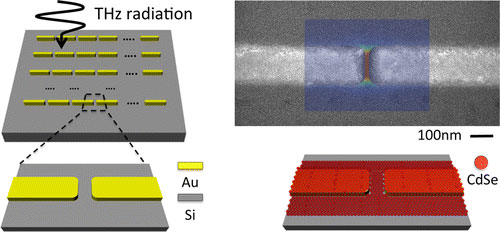| Posted: Jan 28, 2015 |
Joint international research project leads to a breakthrough in terahertz spectroscopy
|
|
(Nanowerk News) Although terahertz spectroscopy has great potential, especially for environmental monitoring and security screening applications, it previously could not be used effectively to study nanocrystals or molecules at extremely low concentrations. An international team led by Professor Luca Razzari at the INRS Énergie Matériaux Télécommunications Research Centre has found a solution to this problem by increasing the technique's sensitivity using metallic nanostructures, as explained in an article published in Nano Letters in January 2015 ("Squeezing Terahertz Light into Nanovolumes: Nanoantenna Enhanced Terahertz Spectroscopy (NETS) of Semiconductor Quantum Dots").
|
 |
| Chains of terahertz dipole nanoantennas spaced by nanogaps of 20 nm allow retrieving the spectroscopic signature of a monolayer of cadmium selenide quantum dots, a significant portion of the signal arising from the dots located within the antenna nanocavities. A Fano-like interference between the fundamental antenna mode and the phonon resonance of the quantum dots is observed, accompanied by an absorption enhancement factor greater than one million. (© ACS)
|
|
Terahertz rays (T-rays) have special properties that are very useful in identifying complex molecules and nanomaterials. However, the very long wavelength associated with this kind of radiation significantly hinders its interaction with nano-objects such as nanoparticles, nanorods, and nanotubes, or large molecules of biological interest. To overcome this limitation, the researchers used nanoantennas to reinforce terahertz spectroscopy, building on an existing strategy that has been successfully employed for other applications such as surface-enhanced Raman spectroscopy (SERS).
|
|
The researchers demonstrated that it is possible to retrieve the spectroscopic signature of a single layer of semi-conductor nanocrystals and increase their absorption by more than a million times when they are placed in the antennas' nanocavities. The unique method they developed to squeeze terahertz light into nanovolumes opens up new research perspectives in nanophotonics and broadens the field of applications in both spectroscopy and nonlinear optics.
|

